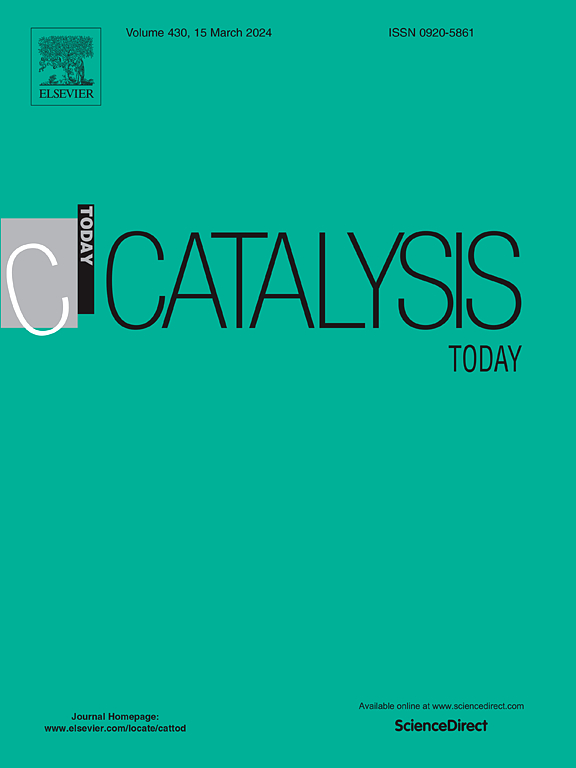Synthesis of Cu-Al hydrotalcite precursors with different interlayer anions for application in the NO reduction by CO
IF 5.2
2区 化学
Q1 CHEMISTRY, APPLIED
引用次数: 0
Abstract
Cu-Al hydrotalcite materials were obtained by coprecipitation with different interlayer anions: carbonate, terephthalate, and tris-dipicolinate cerium complex. Subsequently, they were calcined and tested for NO reduction by CO. The precursors and catalysts were studied to determine their structural, compositional, textural, morphological and reactivity properties. X-ray diffraction, PDF (pair distribution function) simulation and Fourier transform infrared spectroscopy analyses indicated that the hydrotalcite phase was obtained for all precursors with the desired occupation of interlayer anions. Copper reduction was achieved at lower temperatures with catalysts containing cerium, as indicated by TPR, which is correlated with the oxygen vacancies found by XPS and Raman. Through X-ray diffraction, the crystalline copper species present in the spent catalysts were identified: the catalyst from the carbonate precursor exhibited reduced (Cu+ and Cu0) and oxidized (Cu2+) copper species, while the rest of the catalysts only presented the reduced species. Although the catalyst with carbonate between the layers and without Ce is the most active, this activity is related to its high capacity to form N2O at low temperatures, which is undesirable. The highest N2 selectivity at low NO conversions was reached with the catalyst obtained from the terephthalate-precursor and, while at intermediated NO conversions, the highest N2 selectivity was reached with the catalyst originated from cerium complex-precursor.
层间阴离子不同的Cu-Al水滑石前驱体的合成及其在CO还原NO中的应用
用不同的层间阴离子:碳酸盐、对苯二甲酸盐和三-二吡啶酸铈配合物共沉淀法得到Cu-Al水滑石材料。随后,对前驱体和催化剂进行了煅烧和CO还原NO的测试。研究了前驱体和催化剂的结构、组成、织构、形态和反应性。x射线衍射、PDF(对分布函数)模拟和傅里叶变换红外光谱分析表明,所有前驱体都得到了水滑石相,层间阴离子占据了所需的位置。在较低温度下,含铈的催化剂实现了铜的还原,TPR表明,这与XPS和拉曼发现的氧空位有关。通过x射线衍射鉴定了废催化剂中铜的结晶形态:碳酸盐前驱体催化剂中铜的形态为还原铜(Cu+和Cu0)和氧化铜(Cu2+),其余催化剂均为还原铜。虽然层间含碳酸盐且不含Ce的催化剂活性最高,但这种活性与其在低温下生成N2O的高容量有关,这是不希望的。在低NO转化率下,由对苯二甲酸酯前驱体制备的催化剂具有最高的N2选择性,而在中间NO转化率下,由铈络合前驱体制备的催化剂具有最高的N2选择性。
本文章由计算机程序翻译,如有差异,请以英文原文为准。
求助全文
约1分钟内获得全文
求助全文
来源期刊

Catalysis Today
化学-工程:化工
CiteScore
11.50
自引率
3.80%
发文量
573
审稿时长
2.9 months
期刊介绍:
Catalysis Today focuses on the rapid publication of original invited papers devoted to currently important topics in catalysis and related subjects. The journal only publishes special issues (Proposing a Catalysis Today Special Issue), each of which is supervised by Guest Editors who recruit individual papers and oversee the peer review process. Catalysis Today offers researchers in the field of catalysis in-depth overviews of topical issues.
Both fundamental and applied aspects of catalysis are covered. Subjects such as catalysis of immobilized organometallic and biocatalytic systems are welcome. Subjects related to catalysis such as experimental techniques, adsorption, process technology, synthesis, in situ characterization, computational, theoretical modeling, imaging and others are included if there is a clear relationship to catalysis.
 求助内容:
求助内容: 应助结果提醒方式:
应助结果提醒方式:


